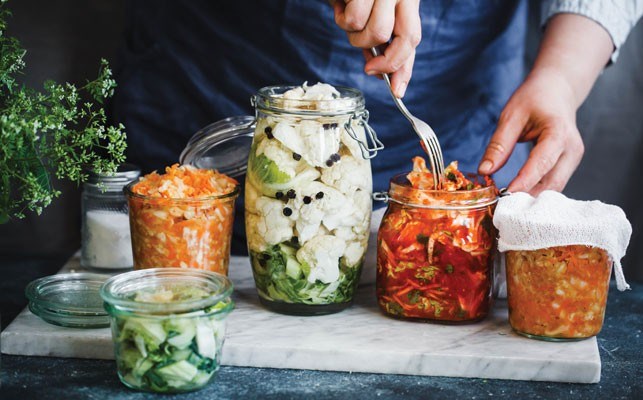Foraging, feasting — and fermenting! If there's one more good F-word to keep in mind for fall it's "fermentation."
This month's beer festival in the village, coupled with all the fine feasting in restaurants and foraging in forests for pine mushrooms and more, reminded me how important fermentation is, and not just in making beer or any alcoholic brew. Fermentation has been key in various cultures throughout history for rendering otherwise indigestible food and drink digestible, as well as preserving it.
If you want to get cheeky, today also marks the start of B.C. Culture Days, so what better way to celebrate the cultures — bacterial and otherwise — we've all come to rely on than saluting our fermented friends.
"Fermentation" simply means the breakdown of something by something else, namely bacteria, yeasts and other microorganisms. It usually involves some kind of effervescence — like that nice bubbling-up effect of yeasts in bread or beer making — and the giving off of heat.
Long ago, people used the term "fermentation" in a whole other sense meaning a state of excitement or agitation, as in, "Whistler this weekend is going to be in high fermentation with Culture Days." A use worth resurrecting around these here parts!
Cheese, cider, kvass (a drink made from Russian black bread, sour and so delicious!); yogurt, kefir, pickles and sauerkraut; all things bread-ish from sourdough pancakes to Afghan bread — all these and more depend on some form or other of fermentation. It's long been a way to preserve foods, especially before refrigeration came along.
For instance, the whole thing about pickled veggies, whether dill pickles, kimchi or sauerkraut, is to establish a colony of good-for-you, healthy microbes in and on a vegetable so that unhealthy microbes you don't want can't set up house.
As fads come and go, fermented foods often rise to the top of the heap like a nicely foaming brew. Kombucha, kefir and good old-fashioned yogurt with their probiotic effects that cultivate desirable microorganisms often anchor diet trends aimed at good health and good waistlines. Usually these foods are indeed good for us but, as always, everything in moderation is the golden rule. Simply incorporate them into your regular eating routines.
Think of tasty Korean kimchi — a combo of Chinese cabbage (napa, bok choy or otherwise) fermented with garlic, red peppers, ginger and more. In the West, it's usually overlooked, foolishly so since the ingredients alone are super healthy before the bacteria even get started.
For people like me who can't digest lactose, kimchi delivers an extra bonus — its probiotic lactic acid bacteria. Kimchi has also been researched for its anticancer, antioxidative, antiobesity properties and more.
On top of good health effects, fermentation adds distinctive flavours and textures. Thai fish sauce, or nam pla, is what it is because of the salt-loving bacteria known as halophiles which ferment the necessary mixture of salt and fish. Halophiles are key to Swedish fermented herring, too.
Sometimes, there's almost no telling where one fermented food or drink leaves off and another starts. Put up your hand if you've ever left your yogurt in the fridge too long and ended up with a cross between cheese and sour cream. Yes, that's classic fermentation at work — or overwork.
Biology professor Besty Dexter Dyer, author of A Field Guide to Bacteria, a book as useful as any field guide to trees or birds, tells us how to make our own vinegar crossing over from wine.
Sometimes wine will transform into wine vinegar on its own, with no help from us. If you have homemade vinegar, you can help the process along by introducing a teaspoonful into the wine (commercial vinegar is sterile so won't work).
If you don't have any homemade vinegar, you can make your own and have some fun while you're at it. (Kids will love this one!) Pour a pint of red wine into a small container and float about a quarter slice of white bread on top. Loosely cover it with a piece of cheesecloth, and leave it alone for about a month.
A white scum and vinegary smell should develop, says Dyer, indicating "the presence of acetic acid bacteria and a successful transformation of wine to vinegar." The scum that forms is called "mother" or "vinegar mother." Use it to make ever more vinegar.
As for "culture," it comes from the Latin word colere meaning to tend or cultivate. Yes, we need to cultivate bacteria and other microorganisms to make delicious food and drink that's good for us, but we also need to cultivate art, so enjoy Whistler's original offerings for Culture Days.
Today, the Audain Art Museum hosts the official launch for Culture Days across B.C. — how cool is that? At Arts Whistler's website, you can find listings for all things "culture" happening at Whistler this weekend — besides the local cheese offerings at stores and the farmers' market along with all the craft beer outlets.
It's all free, including free admission to the Audain Thursday evening starting 6 p.m.; the We Heart Local Art show at the library; hundreds of images from Whistler's saucy past (the '70s and '80s) at Whistler Museum; and the Sketchy Whistler Sketch Crawl. Friday and Saturday you can make your own beautiful lantern for Winter Solstice at the Maury Young Arts Centre. Maybe you'll use it as a centrepiece at your own solstice dinner featuring homemade vinegar and yogurt-cheese.
Glenda Bartosh is an award-winning journalist who cultures many unusual things at home.




